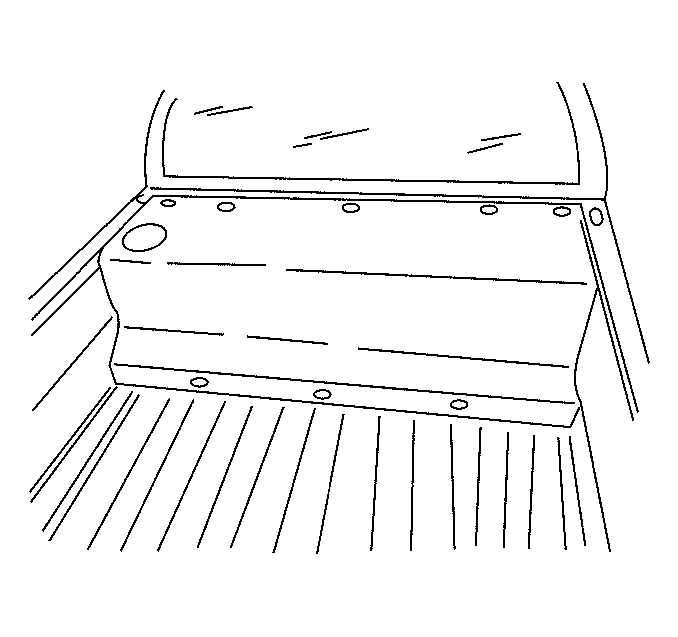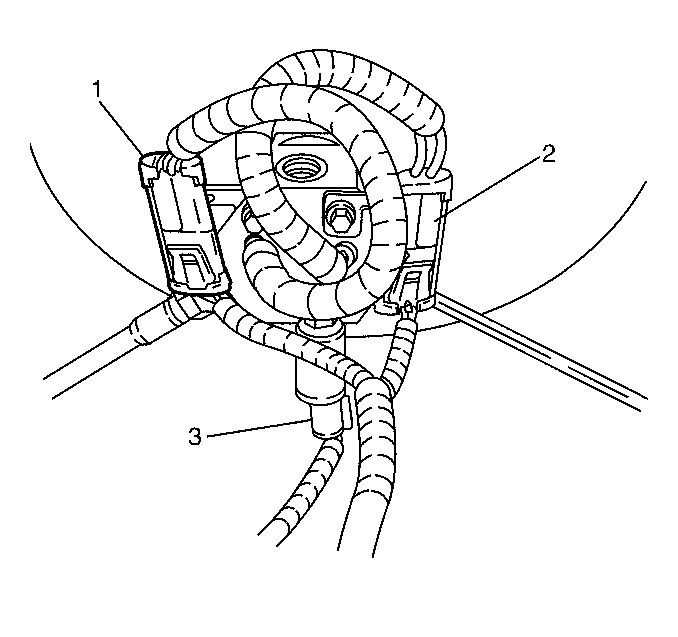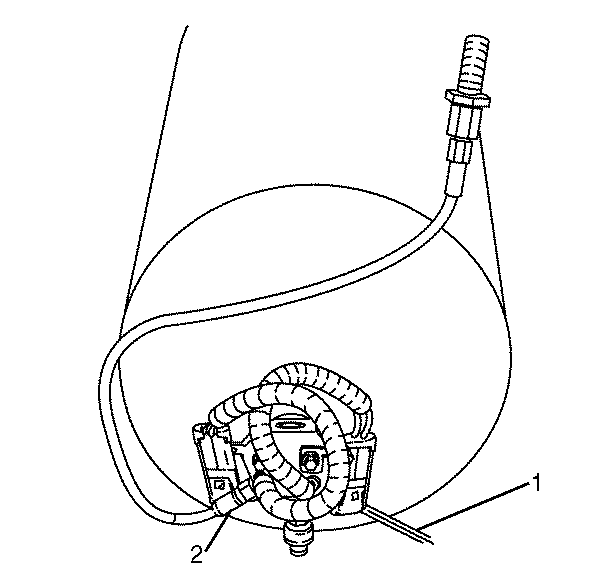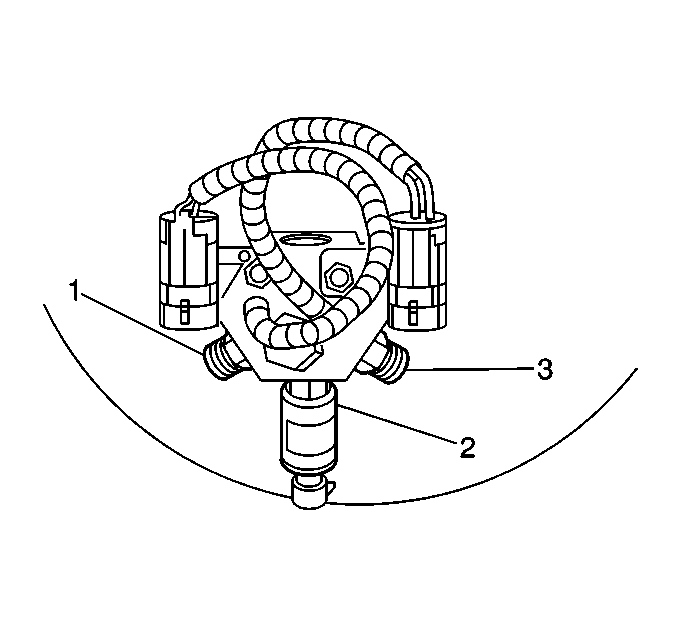Removal Procedure
Tools Required
J 45529 CNG Tank Sling
- Relieve the CNG fuel system pressure. Refer to Fuel Pressure Relief .
- Disconnect the negative battery cable.
- Remove the tank cover. Refer to CNG Fuel Tank Cover Replacement .
- Disconnect the following electrical connectors:
- Disconnect the fill line (2) from the tank. Discard the O-ring face seal.
- Disconnect the fuel line (1) from the tank. Discard the O-ring face seal.
- Remove and discard the nuts and the bolts from the upper mounting brackets.
- Remove the bridge pins and the clevis pins from the upper mounting brackets.
- Remove the upper mounting brackets.
- Use the J 45529 CNG Tank Sling and a suitable lifting device in order to remove the CNG fuel tank.

Caution: Natural gas is highly flammable. In order to reduce the risk of fire and personal injury, keep sparks, flames, and smoking materials away from the vehicle while you perform the Compressed Natural Gas (CNG) fuel system service.
Caution: The Compressed Natural Gas (CNG) system operates at pressures up to 24820 kpa (3600 psi). Relieve the CNG fuel system pressure before servicing CNG fuel system components in order to reduce the risk of fire and personal injury.
Notice: Handle the Compressed Natural Gas (CNG) fuel tank carefully. Do not roll, drag, or drop the tank. If the tank or the carbon wrap is damaged, repair or replace if necessary.
Caution: Unless directed otherwise, the ignition and start switch must be in the OFF or LOCK position, and all electrical loads must be OFF before servicing any electrical component. Disconnect the negative battery cable to prevent an electrical spark should a tool or equipment come in contact with an exposed electrical terminal. Failure to follow these precautions may result in personal injury and/or damage to the vehicle or its components.

| • | The high pressure lock-off (1). |
| • | The fuel temperature sensor (2). |
| • | The fuel pressure sensor (3). |


Disassembly Procedure
Important: Shipping regulations prohibit transporting a fuel tank containing CNG. Vent the fuel tank before shipping the tank. Refer to the Fuel Tank Venting .
If replacing the tank, remove the following components:
- The rubber isolators
- The fuel pressure sensor (2). Discard the O-ring.
- The fuel inlet fitting (1) from the tank valve. Discard the O-ring.
- The fuel outlet fitting (3) from the tank valve. Discard the O-ring.
- Remove and discard the CNG Fuel Only label from the fill door.
- Remove and discard the Bi-fuel Information label from the fan shroud.

Assembly Procedure
If replacing the tank, install the following components:
- Install the fuel outlet fitting (3) to the tank valve using a new O-ring face seal. Lubricate the new O-ring face seal with petroleum jelly or equivalent.
- Install the fuel inlet fitting (1) to the tank valve using a new O-ring face seal. Lubricate the new O-ring face seal with petroleum jelly or equivalent.
- Install the FPS (2) in the tank using a new O-ring face seal. Lubricate the new O-ring with petroleum jelly or equivalent.
- Install the new rubber isolators.
- Obtain a new CNG Fuel Only label and a new Bi-fuel Information label.
- Record the new tank service expiration date on each label.
- Install the new labels.

Notice: Use the correct fastener in the correct location. Replacement fasteners must be the correct part number for that application. Fasteners requiring replacement or fasteners requiring the use of thread locking compound or sealant are identified in the service procedure. Do not use paints, lubricants, or corrosion inhibitors on fasteners or fastener joint surfaces unless specified. These coatings affect fastener torque and joint clamping force and may damage the fastener. Use the correct tightening sequence and specifications when installing fasteners in order to avoid damage to parts and systems.
Tighten
Tighten the fitting to 48 N·m (35 lb ft).
Tighten
Tighten the fitting to 48 N·m (35 lb ft).
Tighten
Tighten the sensor to 27 N·m (20 lb ft).
Installation Procedure
Tools Required
J 41416 Ultrasonic Leak Detector
- Use the J 45529 CNG Tank Sling in order to install the CNG fuel tank.
- Install the upper mounting brackets.
- Install the bridge pins and the clevis pins to the upper mounting brackets.
- Install the new nuts and bolts to the upper mounting brackets.
- Connect the fuel line (1) to the tank using a new O-ring face seal. Lubricate the new O-ring face seal with petroleum jelly or equivalent.
- Connect the fill line (2) to the tank using a new O-ring face seal. Lubricate the new O-ring face seal with petroleum jelly or equivalent.
- Connect the following electrical connectors:
- Connect the negative battery cable.
- Fill the CNG fuel system.
- Start the vehicle and use the J 41416 Ultrasonic Leak Detector in order to inspect for CNG fuel leaks at each serviced fitting.
- Install the tank cover. Refer to CNG Fuel Tank Cover Replacement .

Important: After installation, verify that the distance between the tank (1) and the pickup box (2) is within specification. Verify that the FPS (3) is positioned as shown.

Notice: Use the correct fastener in the correct location. Replacement fasteners must be the correct part number for that application. Fasteners requiring replacement or fasteners requiring the use of thread locking compound or sealant are identified in the service procedure. Do not use paints, lubricants, or corrosion inhibitors on fasteners or fastener joint surfaces unless specified. These coatings affect fastener torque and joint clamping force and may damage the fastener. Use the correct tightening sequence and specifications when installing fasteners in order to avoid damage to parts and systems.
Important:
• Verify that the bridge pins do not contact the CNG fuel tank. • Verify that the rubber isolators are correctly positioned before
tightening the upper mounting bracket fasteners.
Tighten
Tighten the nuts to 48 N·m (35 lb ft).

Caution: Natural gas is stored under high pressure. If a leak occurs, the high pressure could cause a personal injury. In order to prevent Compressed Natural Gas (CNG) fuel leaks, always replace the CNG fuel system O-rings during service.
Tighten
Tighten the fitting to 24.4 N·m (18 lb ft).
Tighten
Tighten the fitting to 37 N·m (27 lb ft).

| • | High pressure lock-off (1). |
| • | Fuel temperature sensor (2). |
| • | Fuel pressure sensor (3). |

